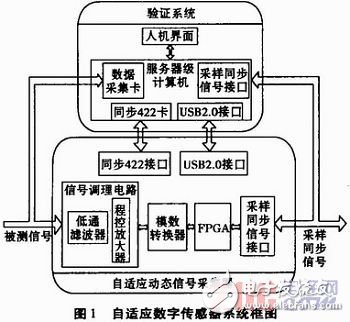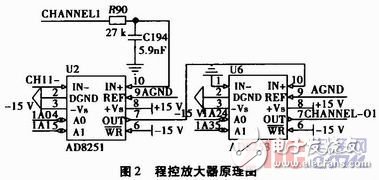The high-range accelerometer typically has a general sensitivity of about 1 mV. When the acceleration signal falls within the range of 1g to 10g, the sensor's output voltage varies between 1 mV and 10 mV. However, traditional testing systems may introduce noise that masks such small voltage signals, leading to incomplete detection of the full acceleration signal. This can result in inaccuracies during data analysis. To address this issue, an adaptive digital sensor is designed to automatically adjust the gain based on the amplitude of the input signal. This ensures that the complete acceleration signal is captured, expands the dynamic measurement range, and enables accurate, digitized, and intelligent measurement of acceleration.
1. Design Scheme 1.1 System OverviewThe adaptive digital sensor consists of two main components: the adaptive acquisition system and the experimental verification system. The adaptive acquisition system serves as the core module of the sensor, responsible for dynamically adjusting the gain, acquiring, storing, and transmitting the conditioned signal. The overall system architecture is illustrated in Figure 1.

The core of the acquisition system uses an FPGA (Field-Programmable Gate Array) as the main controller, ensuring fast processing, real-time performance, and flexibility. This allows the system to handle complex signal conditioning tasks efficiently.
The experimental verification system is used to synchronize the collected signals, validate the results from the adaptive acquisition system, and restore the data back to its original form. It is built on an industrial-grade computer equipped with a high-speed RS422 communication card and an analog data acquisition card. This setup meets the requirements for rapid data acquisition, synchronized communication, large storage capacity, and direct analog signal processing.
1.2 Programmable Amplifier DesignTo effectively capture small signals, the programmable amplifier is essential for scaling different voltage levels. The adaptive digital sensor utilizes a cascaded configuration of AD8251 and AD8253, as shown in Figure 2. The input signal is applied to the "IN+" terminal of the programmable amplifier, and the output is taken from the "OUT" terminal.

The AD8251 offers gain options of 1, 2, 4, and 8, while the AD8253 provides gains of 1, 10, 100, and 1000. By combining these, the total gain can be set to values like 1, 2, 4, 8, 10, 20, and more. The gain is controlled through four control lines (1A0, 1A1, 1A2, 1A3), and the appropriate gain level is selected based on the input signal range, as detailed in Table 1.

The automatic gain switching module is a critical part of the adaptive digital sensor. It is implemented within the FPGA and automatically selects the optimal gain based on the amplitude of the incoming analog signal. This ensures that the measured value maintains sufficient resolution and accuracy. During system startup, the internal gain control unit continuously compares each sampled point from the A/D converter. If the voltage exceeds a threshold, it enters a higher-level comparison; otherwise, it moves to a lower threshold. Finally, the appropriate gain is selected based on the gain level determined.
The workflow of the programmable gain amplifier module is illustrated in Figure 3.

Before each sampling, the PGA gain is set to 1, and the test signal undergoes A/D conversion. Based on the result, the PGA gain is reset accordingly. The adjusted signal is then converted and stored for further analysis.
3. Dynamic Testing of the Adaptive Digital Sensor 3.1 Test Principle, Method, and StepsThe test principle involves the adaptive digital sensor automatically adjusting the gain of the programmable amplifier based on the output voltage of the acceleration sensor. It collects and stores the signal, uploads the data to the verification system, and the verification system synchronizes and compares the collected data to validate the accuracy of the adaptive acquisition process.
The testing method involves placing the acceleration sensor on a shaker table and simultaneously recording its output using a multimeter, the adaptive digital sensor, and the verification system. The data collected by the adaptive sensor is then restored to an actual signal, allowing for performance evaluation based on the measurements. Each test is conducted at ambient temperatures ranging from 20°C to 25°C, with a 30-minute preheating period before starting.
The test procedure includes the following steps:
(1) Place the acceleration sensor on the vibration table and set the frequency to 1 kHz. Adjust the amplitude of the acceleration signal according to the set parameters to vary the sensor’s output;
(2) Apply the acceleration signal to the test rig based on the rotation speed of the ion fan, record the sensor output using a multimeter, and collect data using the high-resolution acquisition card from the adaptive digital sensor and the verification system;
(3) The verification system restores the sensor’s output voltage signal based on the data acquired by the adaptive digital sensor.
The specifications of the tested accelerometer are as follows:
Range: ±5000 g
Sensitivity: 1.098 mV/g
When you think of the screen protectors of old, you're probably thinking of TPU. It's a flexible plastic that's a huge hassle to install . it's flexible, so it can go edge-to-edge on any phone, it has better impact protection than PET, and it has limited "self-healing" powers for small scratches. Brands like TUOLI offer TPU at very affordable prices,
On the other hand, TUOLI's comes in a few different styles depending on the look, feel, and features you want.
Tpu Screen Protector,Hydrogel Protective Film,Mobile Phone Screen Protector,Tpu Hydrogel Film,hydrogel protector, hydrogel sheet
Shenzhen TUOLI Electronic Technology Co., Ltd. , https://www.tlhydrogelprotector.com